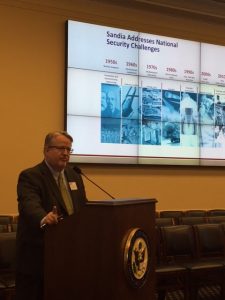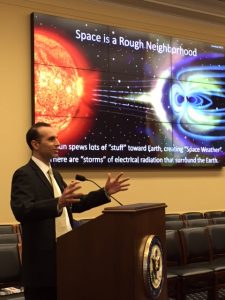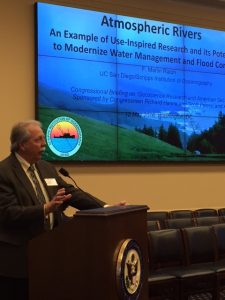May 31, 2016
Geoscience research essential to national security, experts say
Posted by bwebster
By Lauren Lipuma
WASHINGTON, DC — Government investment in basic science research is critical to protecting U.S. national security, according to a group of government and academic researchers. Basic geoscience research has helped the U.S. develop nuclear weapons experts, protect satellites from space weather and manage critical water supplies, scientists said during a recent congressional briefing on Capitol Hill.
The May 12 briefing highlighted national security as an important, but little-known, application of Earth and space science research. Many national security policy issues – from nuclear war to drought – involve the geosciences, and strong federal support for geoscience research programs is invaluable to national security, geoscientists from Sandia National Laboratories, Georgia Institute of Technology and Scripps Institute of Oceanography told congressional staff and representatives from scientific organizations and research institutions.
Basic science investments help train researchers and provide them with knowledge for improving national security, said Erik Webb, manager of the Geoscience Research and Applications Group at Sandia National Laboratories in Albuquerque, New Mexico.
Sandia employs about 250 geoscience professionals, most of whom received some training and support from U.S. government investments in basic science, according to Webb.
Hunter Knox, a Sandia scientist who produces computer and field tools to monitor nuclear weapons tests, become an expert in the field of shallow seismic detection, Webb said.
“The pipeline of talent for our future national security experts depends on basic science investments today,” he said.
Protecting satellite communications
It’s not only events on the ground that affect national security: what happens in space has implications for systems on Earth, according to Morris Cohen, assistant professor of electrical engineering at Georgia Institute of Technology in Atlanta.
“We think of space as being empty and vast, nothing but a vacuum, but it’s not really like that,” Cohen said. “Space is actually a pretty rough neighborhood.”
The sun constantly spews massive amounts of particles and high energy radiation called the solar wind into space. The interaction of the solar wind and Earth’s magnetic field creates an electrical response far above the Earth: a phenomenon called space weather.
Satellites flying through the space weather environment are constantly bombarded by radiation, which degrades and destroys them over time. In addition, when electrical activity is heightened, say during a solar storm, communications and GPS systems can fail and massive power outages are possible.
Studying space weather and other natural phenomena has led to some surprising national security innovations, Cohen said.
In one example, basic lightning research led to new methods for protecting satellites from space weather storms. Scientists discovered radio waves generated by lightning strikes can be detected thousands of miles away. Some of those radio pulses escape into space and neutralize radiation generated by the solar wind. The U.S. Air Force is currently investigating a way to leverage this phenomenon to protect satellites from degradation, Cohen said.
“By studying the physics of how lightning does it… we can begin to engineer a system ourselves to protect satellites and extend their lifetimes,” Cohen said.
Securing natural resources
National security is not only about threats from outside the U.S., but also about protecting valuable resources within our borders like water, according to Martin Ralph, program director of the Center for Western Weather and Water Extremes at Scripps Institute of Oceanography in La Jolla, California.
Water vapor and horizontal winds in the atmosphere create currents called atmospheric rivers that can transport 20 times as much water as the Mississippi River, Ralph said. Atmospheric rivers over the Pacific Ocean affect climate, water and weather in many western states and were at least partly responsible for the “Snowmaggedon” storm that slammed the nation’s capital in February of 2010. Ralph is part of a team working to leverage knowledge of locations and timing of atmospheric rivers to inform water management decisions in California.
The discovery of atmospheric rivers would not have happened without decades of basic research on precipitation, weather, satellite data and more, Ralph said.
“Scientists often tell the story of how the breakthrough advances they’re credited with were not programmed in or anticipated,” he said. “They often came from serendipitous results and a fundamentally creative effort in the sciences.”
Rep. Richard Hanna (R-New York), a member of the Transportation and Infrastructure, and Small Business committees, and Rep. Scott Peters (D-California), who sits on the House Armed Services and Judiciary committees, sponsored the briefing, and the American Geophysical Union hosted it.
— Lauren Lipuma is a public information specialist and writer at AGU.




